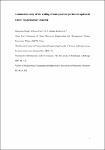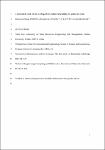A numerical study of the settling of non-spherical particles in quiescent water
| dc.contributor.author | Cheng, X | |
| dc.contributor.author | Cao, Z | |
| dc.contributor.author | Li, J | |
| dc.contributor.author | Borthwick, A | |
| dc.date.accessioned | 2023-11-20T16:11:48Z | |
| dc.date.available | 2023-11-20T16:11:48Z | |
| dc.date.issued | 2023-09-20 | |
| dc.identifier.issn | 1070-6631 | |
| dc.identifier.issn | 1089-7666 | |
| dc.identifier.other | ARTN 093310 | |
| dc.identifier.uri | https://pearl.plymouth.ac.uk/handle/10026.1/21667 | |
| dc.description.abstract |
<jats:p>Settling of non-spherical particles is poorly understood with previous studies having focused mainly on spherical particles. Here, a series of particle-resolved direct numerical simulations are conducted using FLOW-3D (commercial computational fluid dynamics software) for spheres and five regular, non-spherical shapes of sediment particles, i.e., prolate spheroid, oblate spheroid, cylinder, disk, and cube. The Galileo number varies from 0.248 to 360, and the particle Reynolds number Rep ranges from 0.002 77 to 562. The results show that a non-spherical particle may experience larger drag and, consequently, attain a lower terminal velocity than an equivalent sphere. If Rep is sufficiently small, the terminal velocity is less affected by particle shape as characterized by the particle aspect ratio. For relatively large Rep, the shape effect (represented by the Corey shape factor) becomes more significant. Empirical correlations are derived for the dimensionless characteristic time t95∗ and displacement s95∗ of particle settling, which show that t95∗ remains constant in the Stokes regime (Rep &lt; 1) and decreases with increasing Rep in the intermediate regime (1 ≤ Rep &lt; 103), whereas s95∗ increases progressively with increasing Rep over the simulated range. It is also found that in the Stokes regime, particle orientation remains essentially unchanged during settling, and so the terminal velocity is governed by the initial orientation. In the intermediate regime, a particle provisionally settling at an unstable orientation self-readjusts to a stable equilibrium state, such that the effect of initial orientation on the terminal velocity is negligible. Moreover, an unstable initial orientation can enhance the vertical displacement and may promote vortex shedding.</jats:p> | |
| dc.format.extent | 093310- | |
| dc.language | en | |
| dc.publisher | American Institute of Physics | |
| dc.subject | 4012 Fluid Mechanics and Thermal Engineering | |
| dc.subject | 40 Engineering | |
| dc.title | A numerical study of the settling of non-spherical particles in quiescent water | |
| dc.type | journal-article | |
| dc.type | Article | |
| plymouth.issue | 9 | |
| plymouth.volume | 35 | |
| plymouth.publication-status | Published | |
| plymouth.journal | Physics of Fluids | |
| dc.identifier.doi | 10.1063/5.0165555 | |
| plymouth.organisational-group | |Plymouth | |
| plymouth.organisational-group | |Plymouth|Faculty of Science and Engineering | |
| plymouth.organisational-group | |Plymouth|Faculty of Science and Engineering|School of Engineering, Computing and Mathematics | |
| plymouth.organisational-group | |Plymouth|Users by role | |
| plymouth.organisational-group | |Plymouth|Users by role|Academics | |
| dcterms.dateAccepted | 2023-09-01 | |
| dc.date.updated | 2023-11-20T16:11:39Z | |
| dc.rights.embargodate | 2023-11-22 | |
| dc.identifier.eissn | 1089-7666 | |
| rioxxterms.versionofrecord | 10.1063/5.0165555 |



